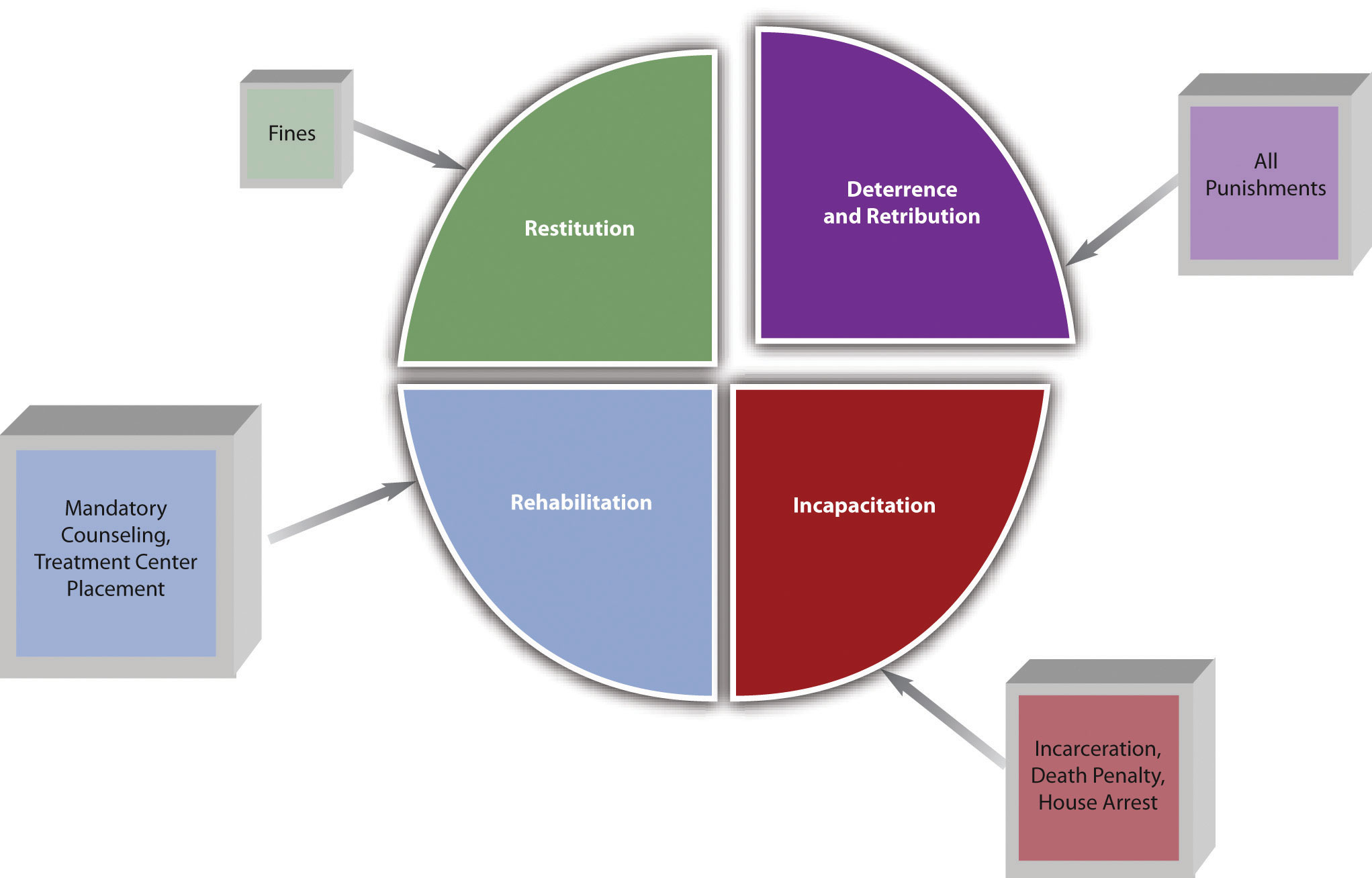This is “The Purposes of Punishment”, section 1.5 from the book Introduction to Criminal Law (v. 1.0). For details on it (including licensing), click here.
For more information on the source of this book, or why it is available for free, please see the project's home page. You can browse or download additional books there. To download a .zip file containing this book to use offline, simply click here.
1.5 The Purposes of Punishment
Learning Objective
- Ascertain the effects of specific and general deterrence, incapacitation, rehabilitation, retribution, and restitution.
Punishment has five recognized purposes: deterrence, incapacitation, rehabilitation, retribution, and restitution.
Specific and General Deterrence
Deterrence prevents future crime by frightening the defendant or the public. The two types of deterrence are specificPrevents crime by frightening an individual defendant. and general deterrencePrevents crime by frightening society with an individual defendant’s punishment.. Specific deterrence applies to an individual defendant. When the government punishes an individual defendant, he or she is theoretically less likely to commit another crime because of fear of another similar or worse punishment. General deterrence applies to the public at large. When the public learns of an individual defendant’s punishment, the public is theoretically less likely to commit a crime because of fear of the punishment the defendant experienced. When the public learns, for example, that an individual defendant was severely punished by a sentence of life in prison or the death penalty, this knowledge can inspire a deep fear of criminal prosecution.
Incapacitation
IncapacitationPrevents crime by removing a defendant from society. prevents future crime by removing the defendant from society. Examples of incapacitation are incarceration, house arrest, or execution pursuant to the death penalty.
Rehabilitation
RehabilitationPrevents crime by altering a defendant’s behavior. prevents future crime by altering a defendant’s behavior. Examples of rehabilitation include educational and vocational programs, treatment center placement, and counseling. The court can combine rehabilitation with incarceration or with probation or parole. In some states, for example, nonviolent drug offenders must participate in rehabilitation in combination with probation, rather than submitting to incarceration.Ariz. Rev. Stat. §13-901.01, accessed February 15, 2010, http://law.justia.com/arizona/codes/title13/00901-01.html. This lightens the load of jails and prisons while lowering recidivismA defendant’s tendency to reoffend., which means reoffending.
Retribution
RetributionPrevents crime by giving victims and society a feeling of avengement. prevents future crime by removing the desire for personal avengement (in the form of assault, battery, and criminal homicide, for example) against the defendant. When victims or society discover that the defendant has been adequately punished for a crime, they achieve a certain satisfaction that our criminal procedure is working effectively, which enhances faith in law enforcement and our government.
Restitution
RestitutionA court order forcing the criminal defendant to pay for harm or the costs of criminal prosecution. prevents future crime by punishing the defendant financially. Restitution is when the court orders the criminal defendant to pay the victim for any harm and resembles a civil litigation damages award. Restitution can be for physical injuries, loss of property or money, and rarely, emotional distress. It can also be a fine that covers some of the costs of the criminal prosecution and punishment.
Figure 1.4 Different Punishments and Their Purpose

Key Takeaways
- Specific deterrence prevents crime by frightening an individual defendant with punishment. General deterrence prevents crime by frightening the public with the punishment of an individual defendant.
- Incapacitation prevents crime by removing a defendant from society.
- Rehabilitation prevents crime by altering a defendant’s behavior.
- Retribution prevents crime by giving victims or society a feeling of avengement.
- Restitution prevents crime by punishing the defendant financially.
Exercises
Answer the following questions. Check your answers using the answer key at the end of the chapter.
- What is one difference between criminal victims’ restitution and civil damages?
- Read Campbell v. State, 5 S.W.3d 693 (1999). Why did the defendant in this case claim that the restitution award was too high? Did the Texas Court of Criminal Appeals agree with the defendant’s claim? The case is available at this link: http://scholar.google.com/scholar_case?case=11316909200521760089&hl=en&as_sdt=2&as_vis=1&oi=scholarr.




